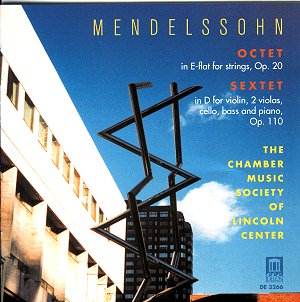Amazingly Felix Mendelssohn was only 15 years
old when he composed his Piano Sextet in 1824. This is scored
for the unusual combination of a single violin, two violas, cello,
double bass and piano, instrumentation which provided the composer
with fascinating musical possibilities as the rich sonorities
clearly demonstrate. Both Mendelssohn and his sister were most
proficient pianists so it is not surprising that the keyboard
is the instrument that has the most prominent role. The Piano
Sextet which has been described as a small scale piano concerto
is an attractive and appealing work with a tremendous immediacy.
The opening movement is alive with ‘free-flowing
flights of runs and arpeggios for the pianist’ (05:50). The piano
soloist receives only polite support from the strings throughout
and there is a general calm feeling suggestive perhaps of relaxing
in a beautiful garden on a warm and sunny summer’s day.
The second movement Adagio is like a slow
movement from a lightly orchestrated piano concerto. The piano
soloist does have interchange with the strings which reminds me
of a first date between a shy teenage boy making tentative conversation
with his demure girlfriend.
Energetic and jaunty, the extremely short Menuetto
marked Agitate displays a more mature and sophisticated
conversation between piano and strings (01:23).
Another showpiece for the piano is the Finale.
Mendelssohn seems to have given the piano soloist free-rein to
show-off to the strings who appear rather subdued offering only
minimal accompaniment (04:17).
It would have been so easy for an obdurate pianist
to be heavy-handed and spoil the balance of the work. The late
David Golub proves to be more than up to the task displaying the
required sensitivity and proves to be a most adept soloist
The Piano Sextet’s main rival (one of few) in
the catalogue is a digital release from the augmented Bartholdy
Piano Quartet on Naxos 8.550967. This is a fine performance and
a particular favourite of mine. Although there have been some
reservations stated concerning the recording balance it has never
impacted on my listening pleasure. However I would now swop my
Bartholdy version for this new Delos release. The players of The
Chamber Music Society of Lincoln Center display a real sense of
enjoyment together with the necessary zest and energy.
Composed a year later, in 1825, Mendelssohn’s
Octet is one of the earliest works for eight string instruments.
Consequently he had no clear models to copy or precedents to hold
to when composing the work. The String Octet is extremely engaging
with that clear stamp of genius and it has been an evergreen favourite
of the chamber music genre. This master work from the 16 year
old Mendelssohn seems reminiscent of childhood innocence and long
hot summer holidays that we never seemed to want to end. The Octet
is a natural progression from Mendelssohn’s earlier youthful string
symphonies. The composer’s directions are particularly apt: ‘this
Octet must be played by all the instruments in the manner of a
symphony’.
I never get tired of hearing the vaulting arpeggio
theme in the opening movement played by the first violin of Cho-Liang
Lin. This gives evidence of the joy to come (00:01). The first
two movements of the Octet alternate between an orchestral aspect
and that of a violin concerto. A good example of the orchestral
tone of the playing can be heard in the second movement Andante
from point 4:13.
Inspired by an episode from Goethe’s ‘Faust’
the third movement Scherzo really demonstrates intelligent
and subtly secure teamwork from the players. They adhere to Mendelssohn’s
sister Fanny’s instruction that the movement ‘should be played
staccato and pianissimo’ (point 0:57). In 1829, in response to
public demand, Mendelssohn was to orchestrate the Scherzo
and use it as a replacement movement in his Symphony No.1 in C
minor.
The Finale is a real tour de force
and here Mendelssohn puts to good use the childhood hours that
he spent copying out Bach’s fugues. The group’s playing
of the brilliant conclusion capped by a melodious coda
is a real delight (4:19).
The String Octet presented here has some fierce
competition in the catalogues. The most notable digital rivals
include versions from the ASMF Chamber Ensemble on Philips Virtuoso
420 400-2PH and Ensemble Divertimenti on Hyperion CDA 66356. My
particular favourite has been the period instrument version from
Hausmusik London on Virgin Veritas 5 61809 2 but not any more
as this new Delos recording is so much more impressive with a
particularly exciting and polished performance.
I knew I was in for a real treat from the first
few bars of this version of the Octet and Sextet. The playing
has a genuine enthusiasm and verve complete with an innate and
classy assurance. I must single out for special praise the playing
of first violinist Cho-Liang Lin who is clearly as fine a chamber
music player as he is a world class soloist in the heavyweight
late-romantic violin concertos in which he specialises. In fact
most of the players are successful and experienced soloists of
the top rank in their own right, a formula which is not always
a guarantee of success. However in these two works the group’s
teamwork, musical intimacy and sense of pleasure from performing
together is a joy to behold. But why, oh why, do the group have
the long winded seven word name, ‘The Chamber Music Society of
Lincoln Center’; when just pronouncing it is a performance in
itself.
The recording has a warm and well focused sound,
nicely detailed with a very natural balance. This Delos release
is a real winner in terms of repertoire, performance, interpretation,
sound quality and sheer enjoyment. Undoubtedly this will be one
of my records of the year.
Michael Cookson
